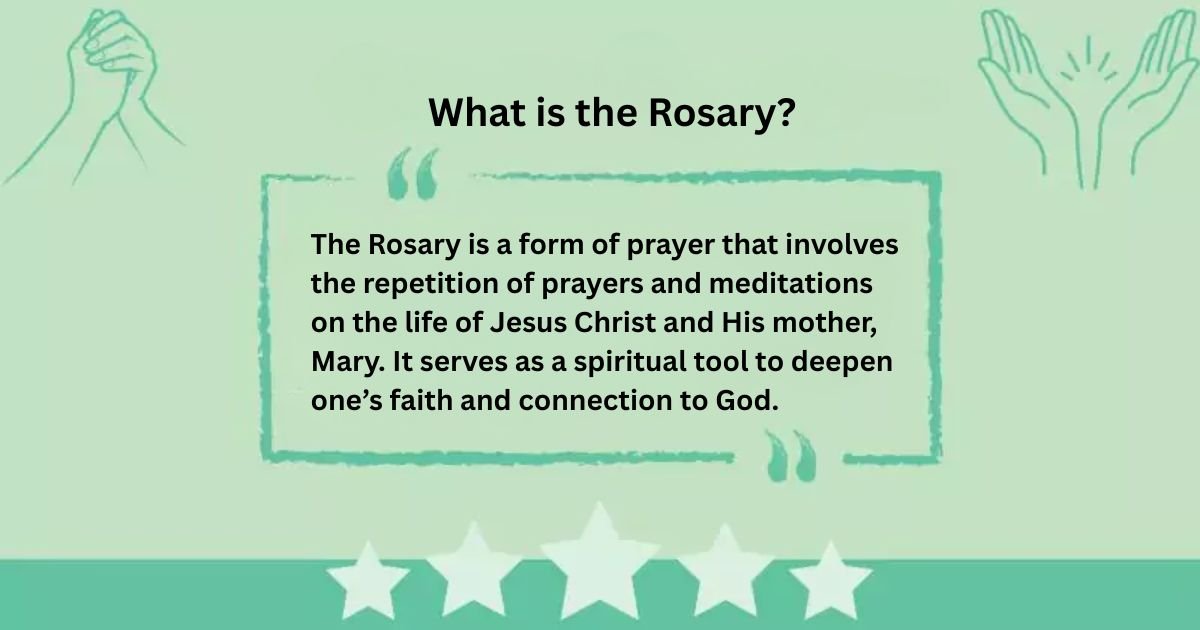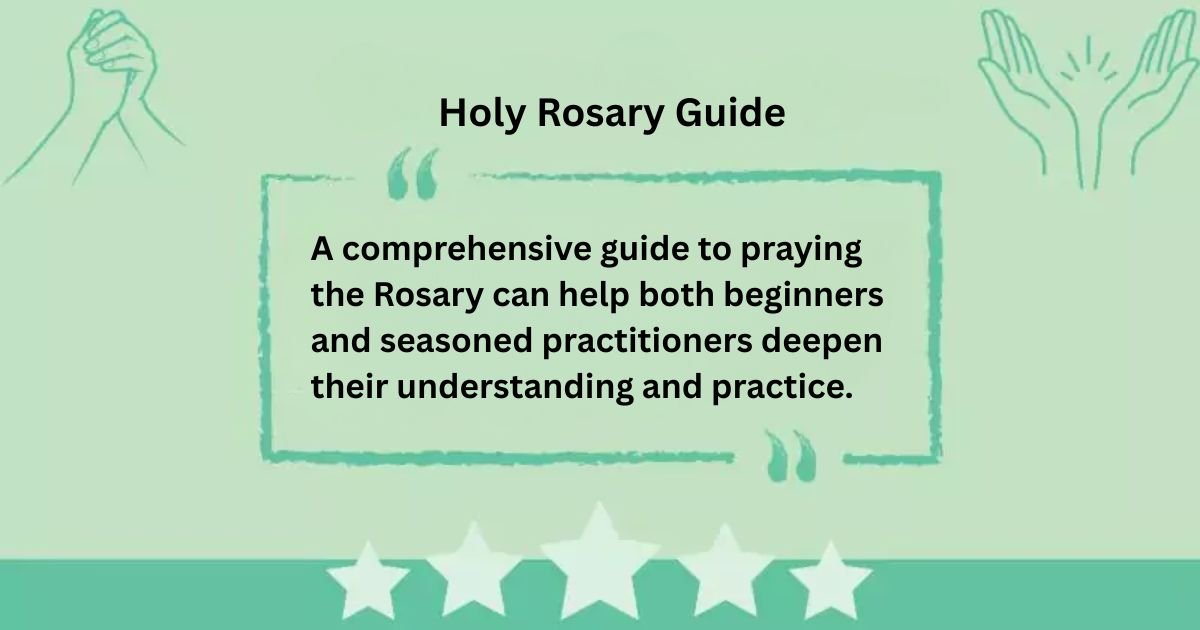The Rosary is a profound spiritual practice that connects millions of people to their faith, offering a unique way to meditate on the life of Jesus Christ and His mother, Mary. This guide will walk you through the process of praying the Rosary, exploring its significance and how it can enrich your spiritual life.
Understanding the Rosary
At its essence, the Rosary is a series of prayers and meditations centered around specific events in the lives of Jesus and Mary, known as “mysteries.” These mysteries are grouped into four categories: Joyful, Sorrowful, Glorious, and Luminous. Each category invites you to reflect on different aspects of faith, hope, and divine love.
Getting Started
To begin, you’ll need a Rosary, which consists of beads arranged in a specific pattern. Each bead represents a prayer, guiding you through your meditation. Here’s a simple step-by-step approach to praying the Rosary.
1. Prepare Your Heart
Find a quiet place where you can concentrate without distractions. Take a few deep breaths to calm your mind and heart. This is your time to connect with God.

2. Make the Sign of the Cross
Start by holding the crucifix of your Rosary. Make the Sign of the Cross and say the Apostles’ Creed, affirming your faith.
3. Pray the Our Father
Move to the first bead and pray the Our Father. This prayer, taught by Jesus, is foundational to Christian faith. As you recite it, reflect on the meaning of each line.
4. Pray Three Hail Marys
On the next three beads, pray three Hail Marys. These prayers are traditionally offered for an increase in faith, hope, and charity. Use this time to consider your own spiritual growth.
Also Read:
24 Prayers for Good Luck
28 St. Anthony Prayer
5. Introduce the Mysteries
Once you finish the introductory prayers, it’s time to meditate on the mysteries. Depending on the day of the week, you’ll focus on different mysteries:
- Joyful Mysteries: Mondays and Saturdays
- Sorrowful Mysteries: Tuesdays and Fridays
- Glorious Mysteries: Wednesdays and Sundays
- Luminous Mysteries: Thursdays
6. Meditate on the Mysteries
For each mystery, announce it aloud. For example, “The First Joyful Mystery: The Annunciation.” Take a moment to reflect on the event and its significance.
As you pray, visualize the scene and think about how it relates to your own life. Allow the mystery to inspire and guide your thoughts during the Hail Marys that follow.
7. Continue the Prayer Cycle
After meditating on each mystery, continue with ten Hail Marys, praying one for each bead. Between each decade of Hail Marys, recite the Glory Be. This pattern repeats for each mystery.
8. Conclude Your Prayer
After you’ve gone through all the mysteries, you may choose to conclude with the Hail Holy Queen, a prayer that honors Mary. This is a beautiful way to finish your Rosary, expressing gratitude for her intercession.
Tips for a Meaningful Rosary Experience
- Consistency: Try to pray the Rosary at the same time each day. Routine can help deepen your practice.
- Personalize Your Prayer: Feel free to include your own intentions or reflections during the prayers. This adds a personal touch to your meditation.
- Engage Your Senses: If possible, use a quiet space, perhaps with candles or soft music, to create an atmosphere conducive to prayer.
- Pray with Others: Consider joining a Rosary group. Praying with others can enhance your experience and create a sense of community.
The Transformative Power of the Rosary
Many find that praying the Rosary transforms their lives. It’s a practice that brings peace, clarity, and a deeper connection to God. As you become familiar with the prayers and mysteries, you might notice changes in your relationships and outlook on life.
What is the Rosary?
The Rosary is a form of prayer that involves the repetition of prayers and meditations on the life of Jesus Christ and His mother, Mary. It serves as a spiritual tool to deepen one’s faith and connection to God.

Origin
The Rosary has its roots in medieval Christianity, evolving from the practice of counting prayers using beads. Over centuries, it has developed into the well-known devotion we recognize today.
Rosary Prayers
Apostles’ Creed
The Apostles’ Creed is a statement of faith that summarizes the core beliefs of Christianity. It is recited at the beginning of the Rosary.
Our Father
The Our Father, or the Lord’s Prayer, is a central prayer in Christianity, taught by Jesus Himself. It emphasizes the relationship between God and His followers.
Hail Mary
The Hail Mary is a prayer asking for the intercession of the Virgin Mary. It consists of two parts: the greeting from the angel Gabriel and an appeal for her prayers.
Glory Be
The Glory Be is a short doxology that praises the Holy Trinity. It is recited after each decade of Hail Marys.
Fatima Prayer
The Fatima Prayer is an additional petition made during the Rosary, asking for the conversion of sinners and peace in the world.
Hail, Holy Queen
The Hail, Holy Queen is a closing prayer that honors Mary as our mother and queen, asking for her intercession.
Mysteries of the Rosary
Joyful Mysteries (Monday, Saturday)
These mysteries focus on the joyful events in the lives of Jesus and Mary, such as the Annunciation and the Nativity.
Sorrowful Mysteries (Tuesday, Friday)
The Sorrowful Mysteries reflect on the passion and suffering of Christ, including the Agony in the Garden and the Crucifixion.
Luminous Mysteries (Thursday)
The Luminous Mysteries highlight key moments in Jesus’ ministry, such as His Baptism and the Last Supper.
Glorious Mysteries (Wednesday, Sunday)
The Glorious Mysteries celebrate the Resurrection and the Assumption of Mary, emphasizing the glory of Christ and His mother.
Why Do We Pray the Rosary?
Praying the Rosary helps us meditate on the key events of our faith, fosters a deeper relationship with God, and encourages reflection on our own lives.
Praying the Rosary Every Day
Making the Rosary a daily practice can enrich your spiritual life, offering peace and clarity amid the challenges of daily living.
Holy Rosary Guide
A comprehensive guide to praying the Rosary can help both beginners and seasoned practitioners deepen their understanding and practice.

The Complete Rosary: A Guide to Praying the Mysteries
This guide provides insights into each mystery, offering reflections and prayers to enhance your meditation.
Rosary Guide English
For English speakers, there are many resources available that provide detailed instructions and prayers for praying the Rosary.
How to Pray the Rosary
Follow this structured approach to praying the Rosary, allowing it to become a meaningful part of your spiritual journey.
Conclusion
Praying the Rosary is more than just a routine; it’s a sacred journey that invites you to reflect on the mysteries of faith. By engaging with this practice, you cultivate a deeper relationship with God and Mary, allowing their lives to inspire your own. Embrace the beauty of the Rosary, and let it guide you on your spiritual path.
FAQ’s
How do you pray the Rosary step by step?
To pray the Rosary, start with the Sign of the Cross and the Apostles’ Creed. Then, pray the Our Father, followed by three Hail Marys and the Glory Be. Continue with the mysteries, praying ten Hail Marys for each decade, and conclude with the Hail, Holy Queen.
How do traditional Catholics pray the Rosary?
Traditional Catholics pray the Rosary by following a structured format, focusing on the prayers and mysteries. They often use specific days for different sets of mysteries and incorporate personal intentions. The prayers are recited with reverence and meditation on the life of Christ and Mary.
How do you say the Rosary properly?
Saying the Rosary properly involves following the established sequence of prayers and meditations. Begin with the crucifix, then recite the Apostles’ Creed, followed by the Our Father, Hail Marys, and the mysteries. Maintain a prayerful attitude throughout, reflecting on the significance of each mystery.
What do the first 5 beads on a Rosary mean?
The first five beads on a Rosary represent the initial prayers: one bead for the Our Father and three beads for the Hail Marys, which are traditionally prayed for faith, hope, and charity. The fifth bead is for the Glory Be. These prayers set the tone for the upcoming meditation on the mysteries.
What happens when you start praying the Rosary?
When you start praying the Rosary, you enter a meditative state, reflecting on the life of Jesus and Mary. It can bring a sense of peace, focus, and spiritual connection. Many find that it deepens their faith and enhances their prayer life.
What is a typical Catholic Rosary?
A typical Catholic Rosary consists of a crucifix, a series of beads grouped into five decades, and a center medal. Each decade allows for meditation on a mystery while praying ten Hail Marys, along with the Our Father and Glory Be. The Rosary serves as both a physical and spiritual tool for prayer.
Should you kneel when saying the Rosary?
Kneeling is a traditional posture for prayer, but it’s not strictly required when saying the Rosary. You can pray while sitting, standing, or kneeling, depending on your comfort and the setting. The focus should be on your heart and intention in prayer.
Is there a right and wrong way to pray the Rosary?
While there is a traditional structure to praying the Rosary, there is flexibility in how you engage with it. The most important aspect is sincerity and focus during the prayers. Personalizing your experience can enhance your connection to God, so there’s not a strict “right” or “wrong” way.
Can you pray the Rosary without the mysteries?
Yes, you can pray the Rosary without specifically meditating on the mysteries, although doing so is encouraged for deeper reflection. You can focus purely on the prayers themselves, using the Rosary as a tool for contemplation. However, the mysteries enrich the experience and provide context for the prayers.








